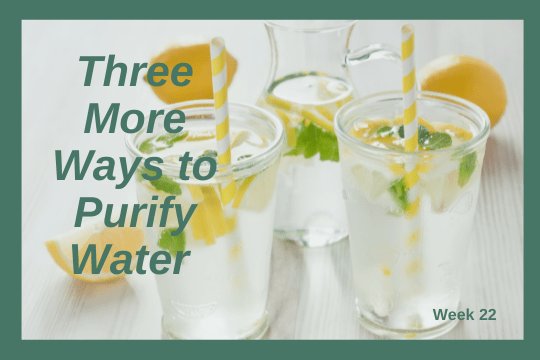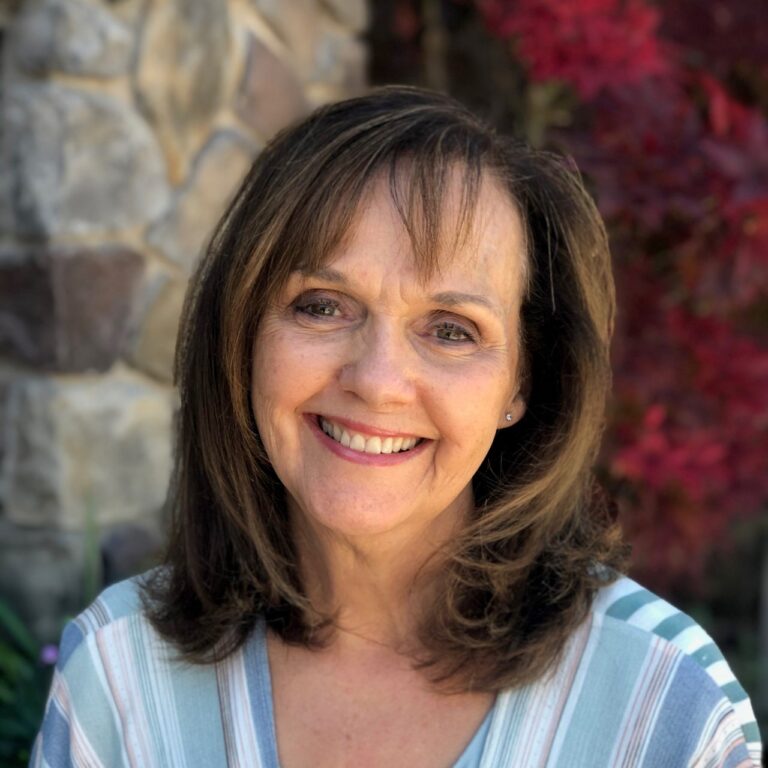Have a Back-Up Plan
An important preparedness principle is to have multiple contingencies for responding to possible crises. When it comes to water preparedness, try to have several methods for obtaining clean drinking water.
In addition to boiling, distillation, and filtration, water can be purified using chemicals that kill harmful pathogens. Chlorine and iodine are the two main chemicals for water purification. Use water treatment chemicals along with filtration if possible.
Preparedness Challenge Week 22
Boiling water is the most effective way to purify water, but boiling is not always possible. Chemical water treatments are an alternative. They are effective, inexpensive, and easy to use methods for purifying water. This week’s preparedness challenge is to add at least one chemical treatment method for purifying water to your emergency supplies. Learn the advantages and disadvantages of three water treatment methods.
This week, add one or more chemical water treatments to your emergency supplies.
Start with the Cleanest Possible Water
WATER SELECTION
Before purifying water with a chemical treatment, it is important to start with the cleanest water possible. Try to select a water source that is free from sewage or unknown floating material and that does not have a dark color or odor. Ideally, use groundwater—the water found underground in the cracks and spaces around soil, sand, and rocks. Or select clear, moving water in streams, canals, and lakes. Collect rain water in clean containers.
STRAINING
Before treating water with any purifying chemicals, remove debris and as many particles as possible. Remove suspended particles by allowing them to settle to the bottom of a container. Strain the clarified water through several layers of filtration material such as coffee filters, paper towels, or a clean porous cloth. Repeat straining if necessary.
Method 1-Household Bleach
Regular household bleach, sodium hypochlorite, is the most available chlorine compound and a common way to purify water.
HOW TO USE HOUSEHOLD BLEACH TO PURIFY WATER
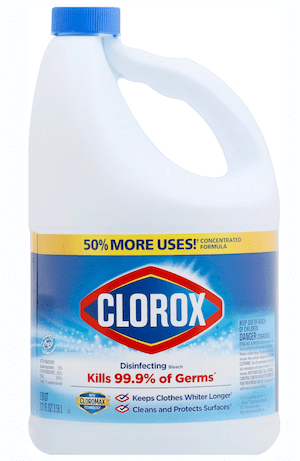
- Strain water of large impurities and settle if necessary.
- Pour the clarified water into a clean container.
- Add 8 drops of regular household bleach per gallon, 2 drops per quart, and ½ teaspoon per five-gallon container.
- Double the amount of bleach if water is cloudy.
- Allow treated water to stand for thirty minutes.
- It should have a slight chlorine odor.If it does not have a chlorine odor, repeat the treatment and let stand for fifteen minutes.
- If chlorine taste is too strong, let water stand overnight or pour from one clean container to another to allow excess chlorine to dissipate.
SHELF LIFE OF CHLORINE BLEACH
Bleach has a short shelf-life—its potency declines 20% per year. Date bleach containers and replace annually to be sure you have fresh and effective bleach.
Advantages and Disadvantages of using Household Bleach to Purify Water
ADVANTAGES OF USING HOUSEHOLD BLEACH
- Easy to obtain
- Inexpensive
- Dissipates quickly
- Highly effective in killing viruses and bacteria in water
- Useful for disinfecting household items
DISADVANTAGES OF USING HOUSEHOLD BLEACH
- Has a short shelf life—begins losing its potency after 6 months
- Potency declines 20% per year
- Has a low effectiveness rate in killing giardia
- Does not kill cryptosporidium
- Corrosive to metal
- Creates dangerous fumes if combined with ammonia-based products
Method 2-Chlorine Dioxide
Chlorine dioxide is the most effective chlorine compound for purifying water. Chlorine dioxide comes in both liquid and tablet form that dissolves in water to release powerful oxidants that are highly effective in killing viruses and bacteria in about fifteen minutes. It also improves the smell and taste of water.
DEALING WITH PROTOZOAN CONTAMINATION
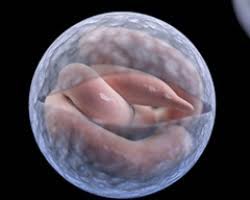
Giardia and cryptosporidium, along with their cysts, are two protozoa that may contaminate water. Chlorine dioxide is effective in killing giardia, but it requires two to four hours. It is less effective in killing cryptosporidium which may be in water contaminated with human or animal feces. It is best to boil or use filtration to purify water you suspect may be contaminated with cryptosporidium.
Most brands of chlorine dioxide offer the same benefits and are easy to find in camping and recreational supply stores or from online sources. The shelf life for chlorine dioxide is four to five years—check the product label of specific brands. All tablets should be stored in a cool, dark, dry location.
AQUAMIRA
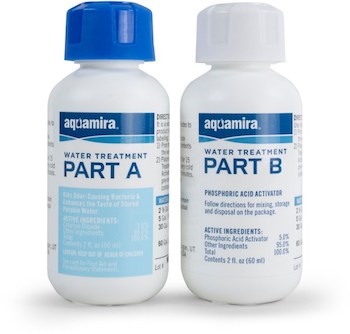
Aquamira has both a two-part liquid treatment ideal for treating larger containers of water. It may also come with droppers that makes it easier to purify water in smaller containers.
Aquamira also makes chlorine dioxide water purification tablets that work best for small liter-size bottles. The shelf life is 4 years.
KATADYN MICROPUR
Katadyn Micropur Purification Tablets dissolve in water, releasing chlorine dioxide. One tablet will purify one liter of water.
POTABLE AQUA CHLORINE DIOXIDE TABLETS
Potable Aqua Chlorine Dioxide Tablets release chlorine dioxide when dissolved in water. Two tablets will purify one quart of water.
Advantages and Disadvantages of Using Chlorine Dioxide to Purify Water
ADVANTAGES
- Convenient and easy to use
- Small and compact, easily portable
- Highly effective against viruses and bacteria
- Moderately effective in killing giardia
- Longer shelf life than household bleach
- Reasonable cost for limited use
DISADVANTAGES
- Susceptible to moisture
- Not very effective in killing cryptosporidium
- Tablets are not suitable for large quantities of water
Method 3-Iodine
Iodine is another chemical that is an effective water purifier for emergency use. Iodine is effective in killing viruses and bacteria. Iodine has a low effectiveness rate for killing giardia and is not effective for killing cryptosporidium.
TINCTURE OF IODINE
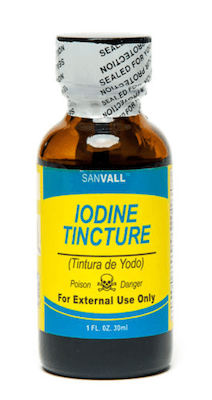
If you have tincture of iodine in your medicine cabinet or first aid kit, it can be used to purify water, if necessary, but there are better options. If you do use tincture of iodine, use five drops of 2% tincture of iodine in a quart of clear water or ten drops in cloudy water. Stir and let water sit for thirty minutes. The water may have an off taste, but adding a vitamin C tablet will improve the taste.
Although iodine water treatments have been perfected in recent years and are easier to use and result in better tasting water, remember that iodine is an emergency water purifier. Like chlorine, iodine is a chemical. Do not plan to use it for a long time. Also, be aware that some people are allergic to iodine.
COGHLANS TWO-STEP DRINKING WATER PURIFICATION SYSTEM
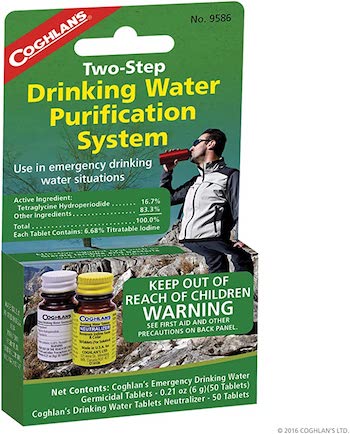
The two parts to the Coghlan Purification System work in tandem. The first iodine based disinfectant tablet purifies the water and the second neutralizer tablet removes the iodine taste and color. The treatment neutralizes viruses, bacteria, and giardia.
POTABLE AQUA PURIFICATION TABLETS
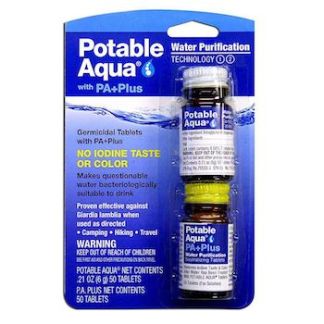
Potable Aqua Purification Tablets and Water Purification Neutralization Tablets is a similar iodine water purification system. The purification tablets kill bacteria and giardia and the vitamin C tablets neutralize the iodine taste. They have a shelf life of four years if unopened.
Advantages and Disadvantages of Using Iodine to Purify Water
ADVANTAGES
- Convenient and easy to use
- Inexpensive
- Highly effective against viruses and bacteria
- Moderately effective in killing giardia
DISADVANTAGES
- Susceptible to moisture
- Water may have off-taste or color
- Not effective in killing cryptosporidium
- Not recommended for use for longer than three weeks
- Tablets are not suitable for large quantities of water
LEARN MORE
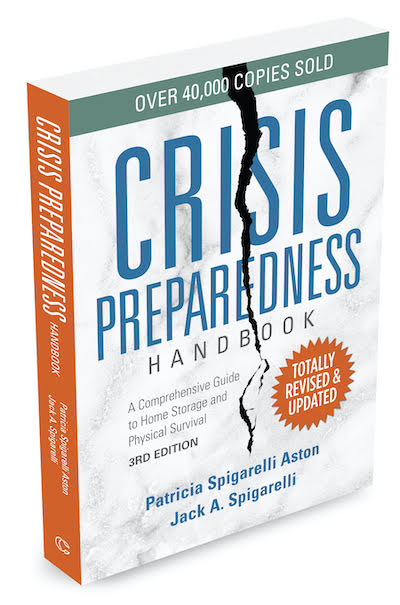
Find out about more methods for purifying water in an emergency—as well as tips for storing and filtering water in my book Crisis Preparedness Handbook, Third Edition (2020). Also learn about all aspects of preparedness. You will get valuable checklists, quick-start ideas, worksheets, and personal tips to make it easy. If you don’t already have a copy, you can find it here on my website CrisisPreparedness.com. Or, read it on Amazon in the Kindle version or hard copy version.
